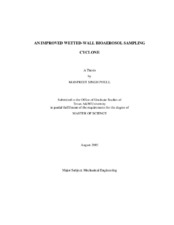| dc.description.abstract | A modified wetted-wall cyclone using different methods of water injection techniques
upstream of the inlet was designed as an improvement to a wetted-wall cyclone developed
by White, which uses liquid injection through a port on the wall of the cyclone inlet. The
new cyclone has a high aerosol sampling flow rate (1250 L/min) and maintains constant
cut-point with the modified White-type cyclone along with greater collection efficiency,
lower time response, and reduced pressure drop.
The final air-blast atomizer cyclone (AAC2.1a) design considered has an aerosol-tohydrosol
collection efficiency cut-point of 1.3 mm with collection efficiencies at 1 and 2
mm of 39.9% and 86%, respectively. The efficiency reported for the modified White-type
cyclone for particle sizes of 1 and 2 mm was 40.5% and 76.3%, respectively, under no
water bypass conditions. The aerosol-to-aerosol transmission efficiency for the AAC2.1a
configuration was found to be approximately 53.7% for 1 mm diameter particles as
compared with 67.2% for the modified White-type cyclone.
Dry and wet time response tests were performed in which the modified White-type cyclone
had an initial response of 2.5 minutes for a wet start and 1 minute for a dry start for a
condition where there was no liquid carryover through the cyclone outlet. The rise time for
AAC2.1a cyclone under dry and wet start conditions was 0.5 minutes and 1.3 minutes,
respectively. The decay response of the modified White-type cyclone was 1.1 minutes for a wet start and 1.2 minutes for a dry start. The corresponding numbers for AAC2.1a cyclone
were 1.4 minutes for a dry start and 1 minute for a wet start condition.
Off design tests were run at approximately ±10% air flow rates to see the effect on cyclone
performance. It was seen that at a 10% higher flow rate (1350 L/min) the efficiency was
54.3%. At a 10% lower flow rate (1125 L/min) the efficiency was 33.7% as compared with
an efficiency of 39.9% at 1250 L/min for 1.0 mm PSL particles. It was found that at a water
input of 0.8 mL/min the efficiency reduced to 79.3% as compared to 86% at an input flow
rate of 1.6 mL/min for 2 mm size PSL. | en |


